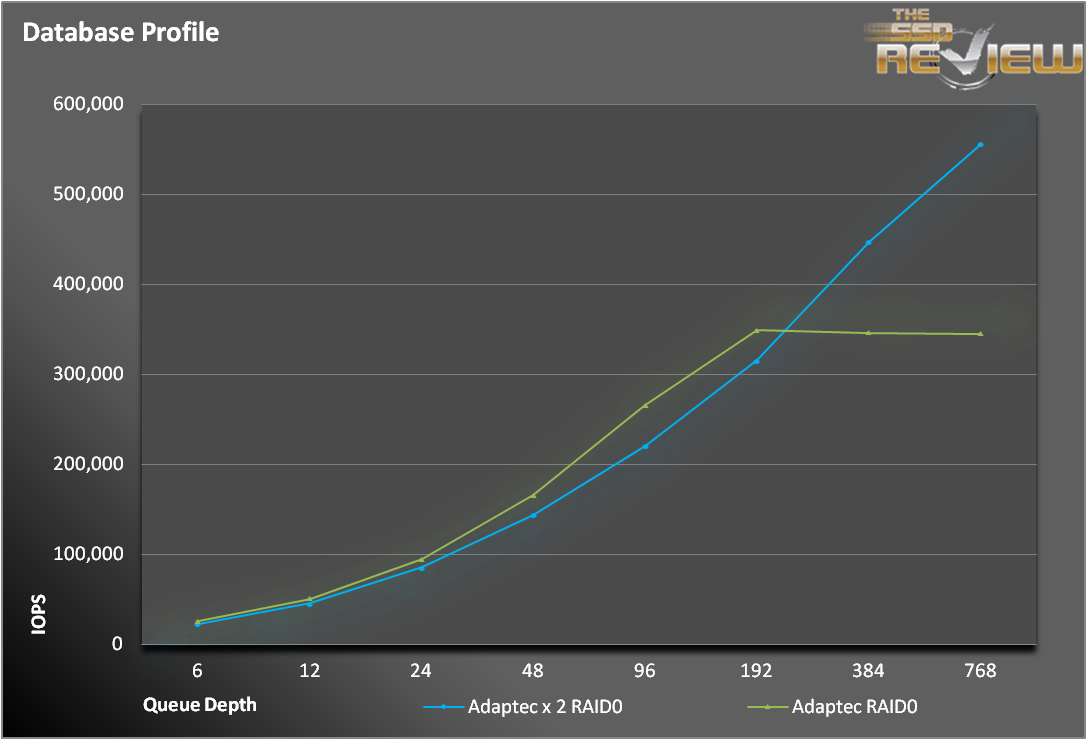SERVER PROFILES
While synthetic workloads do a great job of testing the underlying technology and reporting easy to understand results, they aren’t always indicative of how the drive will be used by the end user. Workloads that simulate enterprise environments try to bridge that gap without being overly complex.
The database profile is 8K transfers, and 67% percent of operations are reads.
The fileserver profile is based on an 80% read/20% write mix. Its made up of blocksizes from 512 to 64K, each making up a different percentage of the access pattern.
The pattern is: 512 bytes=10%, 1k=5%,2k=5%, 4k=60%, 8k=2%, 16k=4%, 32k=4%, 64k=10%.
The webserver profile is similar to the fileserver profile, but has some additional 128K and 512K accesses thrown in for good measure. Additionally, the profile is 100% read.
Overall, the Adaptec/SMART solution blew through the server profiles as if they were synthetic 4KiB operations. The mixing and matching of transfer sizes and read/write operations had negligible affects on the results. The database profile results, specifically, showed little slowdown with the mixed workload. This aligns well with the results we observed in the SNIA testing.
One thing to note is that all profiles needed a very large queue depth (QD=192) to hit their maximum performance. We probably could have squeezed a few more IOPS out of the dual-adapter configuration, but we stopped at a QD of 768.
 The SSD Review The Worlds Dedicated SSD Education and Review Resource |
The SSD Review The Worlds Dedicated SSD Education and Review Resource | 


In many published reports a single optimus cannot provide latency performance within that tight of a range. These are obviously system cache results.
All caching was disabled, except for any write coalescing that the ROC was doing behind the scenes. You have to remember that the SSDs were not the bottleneck on the latency measurements, in fact, they were only going at 40% of their specified rates. Also, every test we have performed, and other sites as well, show the Optimus to be a very stable SSD. So, to your point, there is some amount of caching happening outside of the DRAM, but it very limited.
Any chance of reviewing the 71605Q, see how it stands up with 1 or 2TB worth of SSD cache and a much larger spinning array? Since it comes with the ZMCP (Adaptec’s version of BBU) you can even try it with write caching on.
I’d especially love to see maxCache 3.0 go head to head with LSI CacheCade Pro 2.0
Considering I actually already own the 71605Q, and bought practically “sight unseen” as there are still no reviews available it is nice to see that the numbers on the other cards in the line are living up to their claims.
Like I said in the review, I wish we had the time and resources to test out all combination, but we can’t get them all. I have both the 8 and 24-port versions and, yes, they always hit or exceed their published specifications. I agree, that would be a great head-to-head matchup, We have a lot of great RAID stories coming up, maybe we can fit it in. Thanks for the feedback!
Yeah after I posted that I started brainstorming all the possible valid combinations you could test with those two cards and there’s quite a few permutations… Also might not be too fair to the older LSI solution but it’s what they have available and I don’t know of any release schedule for CC 3.0 or next gen cards, so might not hurt to wait for those.
I guess the best case to test would be best case cache worst case spinners, so RAID-10/1E SSDs with RAID-6 HDDs. See how the two solutions do at overcoming some of the RAID-6 drawbacks esp the write penalty.
I’m guessing the results would probably be fairly similar to the LSI Nytro review but still would be interesting to see how up to 2TB of SMART Optimus would do with a 20TB array.
Nice! How did you manage to connect the two cards (X2)?
“..We were able to procure a second ASR-72405 and split the drives evenly across the two…”
See my comment
I’m assuming they made a stripe on each raid card and then did a software raid 0 stripe of the arrays into one volume. That would be why the processors showed 50% until under load.
Great review though that SSD has me worried for sustained enterprise usage.